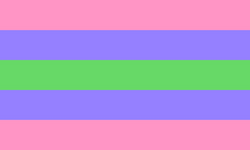Trigender: Difference between revisions
No edit summary |
Amazingakita (talk | contribs) m (Reverted edits by 209.97.138.73 (talk) to last revision by TXJ) |
||
| Line 1: | Line 1: | ||
{{uncommon identity}} | |||
{{infobox identity | |||
| name = Trigender | |||
| flag = trigender.png | |||
| related = [[multigender]], [[polygender]], [[bigender]], [[pangender]] | |||
| percentage = 0.1 | |||
| gallery_link = Pride Gallery/Trigender | |||
}} | |||
'''Trigender''' is a [[gender identity]] under the [[multigender]] and [[transgender]] umbrella terms. Trigender people experience exactly three genders, either simultaneously or moving between the three (the latter one being under the [[genderfluid]] umbrella too).<ref>Leslie Feinberg, ''Trans Liberation: Beyond Pink Or Blue'', page 53-4, Beacon Press, 1999, ISBN 0-8070-7951-0, ISBN 978-0-8070-7951-5.</ref><ref>Alexia Elejalde-Ruiz, "[http://articles.chicagotribune.com/2009-11-18/news/0911180173_1_gender-born-layers For the young, gender is fluid]", ''Chicago Tribune'', November 18, 2009.</ref> These three genders can be any gender, either binary or nonbinary.<ref>Maurianne Adams, Lee Anne Bell, Pat Griffin, ''Teaching for diversity and social justice'', page 224,CRC Press, 2007, ISBN 0-415-95200-X, 9780415952002.</ref> | |||
== | ==History== | ||
Trigender was mentioned as one of many valid nonbinary identities in the 2013 text ''Sexuality and Gender for Mental Health Professionals: A Practical Guide''.<ref>{{cite book|isbn=9781446293133|title=Sexuality and Gender for Mental Health Professionals: A Practical Guide|last1=Richards|first1=Christina|last2=Barker|first2=Meg|year=2013|publisher=SAGE Publications}}</ref> | |||
== See also == | |||
* [[Multigender]] | |||
* [[Genderfluid]] | |||
* [[Bigender]] | |||
== | == References == | ||
<references />{{Stub}} | |||
[[Category:Nonbinary identities]] | |||
[[Category: | |||
Revision as of 16:21, 1 July 2020
| |
This page is about a gender identity that is not widely used among gender-variant people. This does not mean that the identity is not valid, but that very few people are known to use this term. More information on uncommon identities... |
 | |
| Related identities | multigender, polygender, bigender, pangender |
|---|---|
| Click here to see alternative flags! | |
Trigender is a gender identity under the multigender and transgender umbrella terms. Trigender people experience exactly three genders, either simultaneously or moving between the three (the latter one being under the genderfluid umbrella too).[1][2] These three genders can be any gender, either binary or nonbinary.[3]
History
Trigender was mentioned as one of many valid nonbinary identities in the 2013 text Sexuality and Gender for Mental Health Professionals: A Practical Guide.[4]
See also
References
- ↑ Leslie Feinberg, Trans Liberation: Beyond Pink Or Blue, page 53-4, Beacon Press, 1999, ISBN 0-8070-7951-0, ISBN 978-0-8070-7951-5.
- ↑ Alexia Elejalde-Ruiz, "For the young, gender is fluid", Chicago Tribune, November 18, 2009.
- ↑ Maurianne Adams, Lee Anne Bell, Pat Griffin, Teaching for diversity and social justice, page 224,CRC Press, 2007, ISBN 0-415-95200-X, 9780415952002.
- ↑ Richards, Christina; Barker, Meg (2013). Sexuality and Gender for Mental Health Professionals: A Practical Guide. SAGE Publications. ISBN 9781446293133.
| |
This article is a stub. You can help the Nonbinary wiki by expanding it! Note to editors: remember to always support the information you proved with external references! |
